Log Cabin Roof Ideas – Best Way To Roof Log Cabin
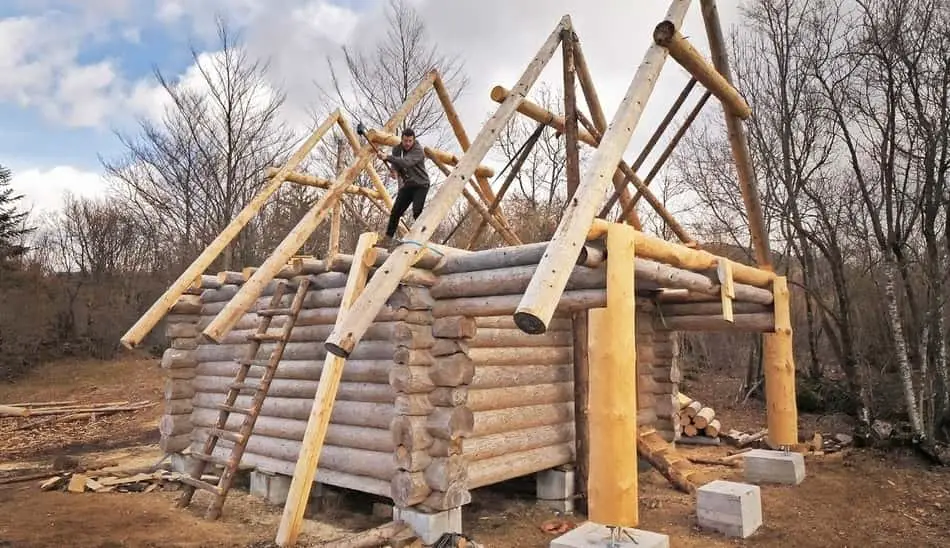
If you have decided to build a log cabin, but you don’t know what type of roof you’ll put on it? Many different types of roofs can fit into a log cabin, so choosing the ideal one can sometimes be difficult. The roof is considered one of the most important external finishes that may make or break its success. You must ensure that it is well-built and maintained, so it’s safe to live in.
The first step before building a log cabin is to become familiar with your local planning and building codes. Construction rules vary from state to state, and there may be some restrictions on the materials you can use, the maximum height of your log cabin, and how close you can construct to the plot border if you desire a bit taller cabin.
Since you don’t want to build your dream log cabin illegally, make sure that everything is planned and ready with your local agencies. In this article, we’ll talk about log cabin roof ideas and much more. So, let’s start!
Table of Contents
Two Types Of Log Cabin Roofs
Before you start, you must first decide what type of roof you want: a pitched roof or a flat roof.
Usually, there are two aspects you want to look at before choosing your roof. The first one is local weather conditions, and the other one is your personal preference and what you find more visually pleasant.
1. Pitched Roof
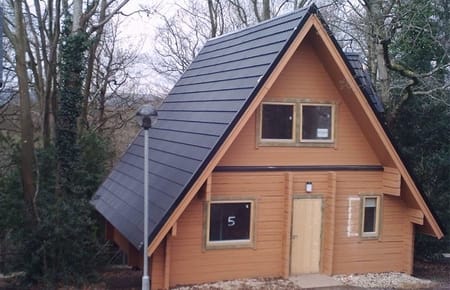
Every roof with one or more surfaces with a slope of more than 10% is considered a pitched roof. This type of roof is visually more appealing and, when properly made, they fit well with log cabins.
Rain and snow are less likely to get caught between your log cabin’s shingles or other roofing elements if your roof has a higher pitch and if it is steeper. This will also allow your roof to dry faster since rain and snow will run off the roof immediately. However, more materials and labor are required for this option, so the build will be more expensive.
Note! Pitched roofs are problematic in stormy and windy places, as powerful gusts of wind can get under the roof, and cause the roof to lift off the walls. This could be prevented with the right materials and by using the right bracing.
In snowy areas, a pitch of at least 40° angle or 10/12 is recommended.
2. Flat Roof
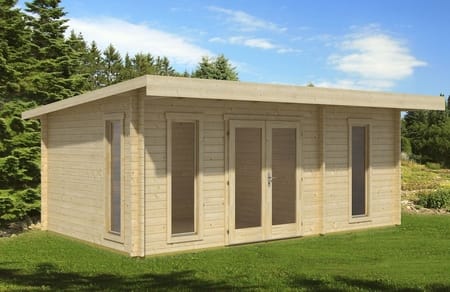
A flat roof is frequently a cheaper alternative compared to a pitched roof since it requires fewer materials and it can be built much faster, which will result in lower labor expenses. Interestingly, it is possible to install a flat roof in a single day.
Even though they are called flat roofs, they also have a small slope to enable water to drain off, so you shouldn’t be deceived by the word “flat”. Flat roofs provide more space on your roof, and that’s why people opt for them. That way you can create a living space, or even make your log cabin more energy efficient by installing solar panels.
Dryer climates are more suitable for flat roofs because they are more prone to leaks, particularly when it is raining a lot. Due to the weight of the snow, flat roofs may not hold up due to constant force. So you shouldn’t use them if you need to roof a larger area, because it will be unstable under heavy rains and snow.
Note! Keep in mind that flat roofs usually last around twenty years. This is why you should consider if a flat roof is the best option for you just because the initial cost of installation is low.
Here is also one interesting article where we talk about Can A Log Cabin Be Moved. Be sure to read it.
Choosing Log Cabin Roofing Materials
After you’ve decided whether you’ll have a flat or pitched roof, as well as the angle of the pitch, you’ll need to choose a suitable material for your roof. This decision can be based on price, aesthetics, personal preferences, and energy efficiency.
There is a big variety of materials that you can use for the roof on your log cabin, however, the ones covered in this article are:
- Wood Shingles
- Metal Sheeting
- Felt shingles
- Felt Roof
- EPDM Rubber Roof
- A Green Roof
Each of these materials comes with a range of benefits and disadvantages. Here we’ll analyze each of them so you can decide which one suits you best.
1. Wood Shingles
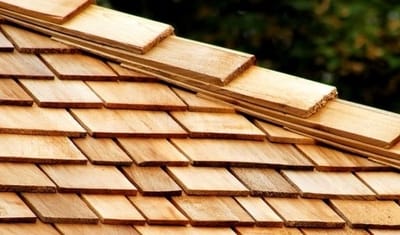
Wood shingles are probably the most aesthetically beautiful alternative for roofing your log cabin. Although Cedar roof shingles are one of the more costly solutions, they give your log cabin a classic look while still keeping it natural. They also have a long life, and while aging, they transition from a warm red to a lovely silvery grey. The wood shingles price ranges between $50-$100 per m2, but it is worth it if you want to live in luxury.
2. Metal Sheeting
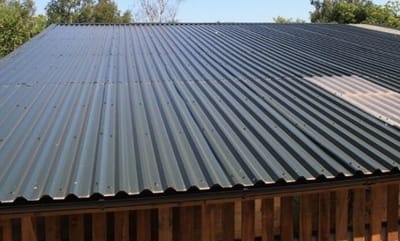
Metal sheeting is usually used in commercial log cabin building, although it might still be useful in a private log cabin concept while being an industrial component.
You can save a lot of time and work in the construction process if you go with the pre-insulated metal panels. This is a fast and simple way to cover a roof. With a good protective finish, metal will endure a long time, and it may also look extremely elegant. We would like to highlight the Metro tile design as one of the most attractive options out there.
Rust and discolor might become a problem very easily if your cladding metal has a poor or has no protective surface at all. However, if you opt to go without insulation, rain noise can bother you during peaceful days and nights. Metal cladding in the Metro design typically costs between $15 and 50$ per square meter.
3. EPDM Rubber Roof
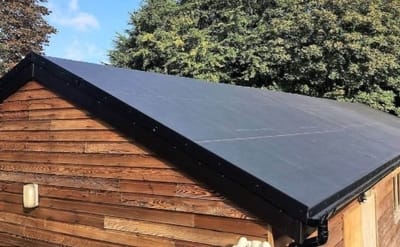
The EPDM Rubber roof is the way to go if you need a quick and straightforward way to cover your log cabin roof. This material is far less complicated to install than a standard traditional roof felting. EPDM Rubber, unlike felting, can be ordered to the exact size and dimensions required, making leaks nearly impossible if it is done correctly. It can also be installed in one piece.
This is a great DIY option! Before you start installing your roof, you will need the following things: EPDM rubber and an EPDM glue paste.
We will now explain how to install your EPDM rubber roof in 5 quick steps:
- Apply the paste to your roof board
- Roll out the rubber roof
- Brush away any air pockets
- Nail the sides of the rubber right into the logs creating the cabin’s side
- Lastly, add plastic trimming to guarantee that rainfall drains off.
EPDM is highly durable and it also has a high resistance to heat, water, and UV.
The EPDM glue dries out over time or fails to bond due to contact with standing water, which is a concern. This roofing choice costs roughly between $10 and $16 per square meter, and every 5-10 years, you will need to repair your rubber roof.
4. Thatched Roof
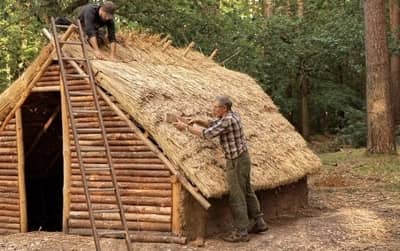
The Thatched roof is a less common option due to its price and the difficulty of the thatching procedure. This is likely one of the most costly options to roof a log cabin, where the price ranges from $280 per square meter, depending on the area and reed quality. A log cabin with a thatched roof should have a roof that is the pitch of at least 40 degrees, to allow snow and rain to flow off easily. Although it is a bit pricy, it will give your log cabin a magnificent finish.
5. Felt Roof
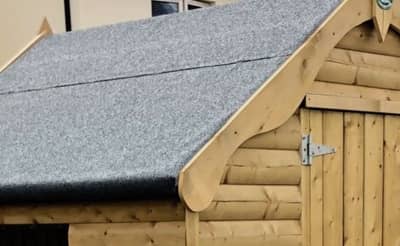
The Roofing felt is one of the most inexpensive choices you can go for. Its life expectancy depends on quality and grade, but they usually last between five to ten years on average. It is a very simple and quick way to cover your log cabin roof. To help you merge your log cabin into its environment, felts are available in various colors.
Roofing felt costs roughly $10 per square meter on average. Felt roofing has the disadvantage of having a lower resale value and necessitating more care and inspections than a standard pitched roof.
6. Felt Shingles
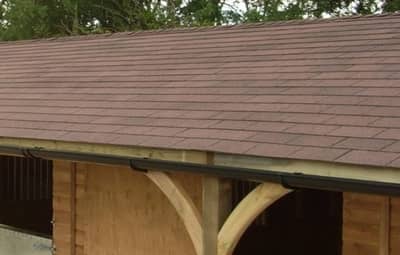
The Felt shingles are typically thicker than other roofing options, and they come in 1-meter-long strips. They have a longer life expectancy than roll shingles, lasting roughly 20 years. The sticky coating that most felt shingles have helps them to cling together when they become heated. This is the reason they are difficult to lay in cold weather.
To stick them together in cold weather, you can use a blow torch or something similar to warm them. However, be cautious and follow the manufacturer’s directions since heating some felt shingles might damage them or and can even be dangerous.
They come in a variety of colors and forms, much like the roofing felt. They are more expensive than felt on a roll, but keep in mind that they will save you money in the long run, thanks to their extended lifespan. Felt shingles cost roughly $12 per meter square on average.
7. A Green Roof (Living Roof)
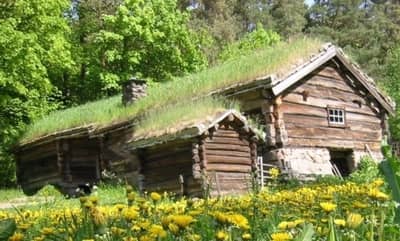
The Green Roof isn’t the cheapest option for a log cabin roof, but it is the most environmentally friendly alternative. However, you must be careful of things like the soil’s weight on the roof, particularly when it is soaked with rain. A strongly reinforced roof would be required for your log cabin to be constructed properly. This roof can also be extremely attractive if it is done right, making your log cabin look magnificent.
Since it can give an extra layer of insulation to your roof and provide micro-climates for birds and insects, it may be energy-efficient and low-maintenance if done appropriately.
Based on the plants you want to add and your log cabin’s location, the price of a green roof varies. Here is a step-by-step method for how to have a green roof. The following are the most crucial points to keep in mind.
- To save time and money, apply for and acquire planning clearance before beginning your project.
- Roof pitch is generally determined by where you live, because of the weather conditions and cost. If you live in a rainy area, you will have to go with more expensive pitched roofs, but if you live in a drier area, you can go just for a regular pitched roof or a flat roof.
- It’s all about the materials! Consider cost, aesthetics, structural load, water, labor, insulation, soundproofing, and upkeep when selecting materials that meet your demands.
- Check your building codes in effect in the region.
If you want to learn more, be sure to read Can Log Cabins Have Basements?
Final Thought
As we have gone through all the important topics in this article about roof ideas, we can say that it all comes down to your personal choice. While it is not always easy, it is necessary to persevere because the result will come. If you have never roofed a log cabin before, now you have the chance to do it. I hope that this article has helped you and if you have any additional questions feel free to ask.


Can you be more specific about the content of your article? After reading it, I still have some doubts. Hope you can help me. https://www.binance.info/join?ref=YY80CKRN
Can you be more specific about the content of your article? After reading it, I still have some doubts. Hope you can help me.